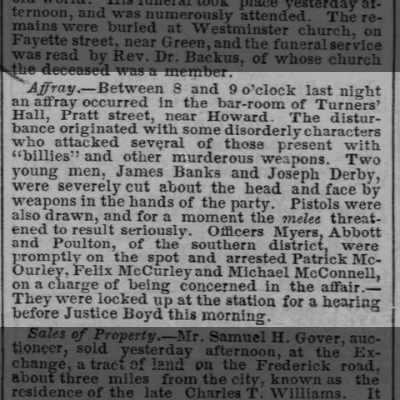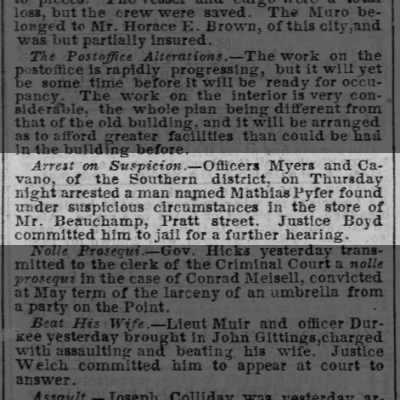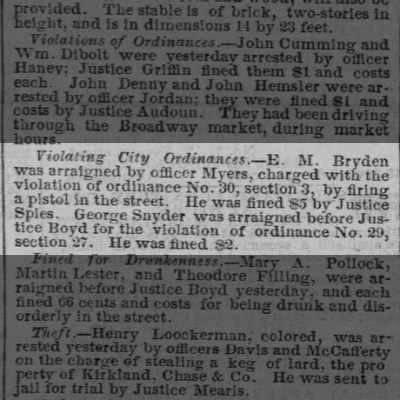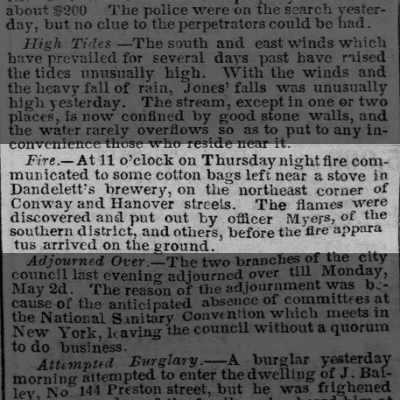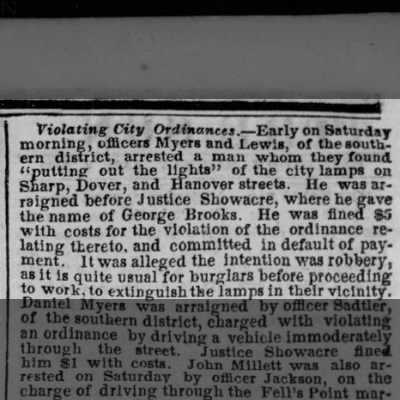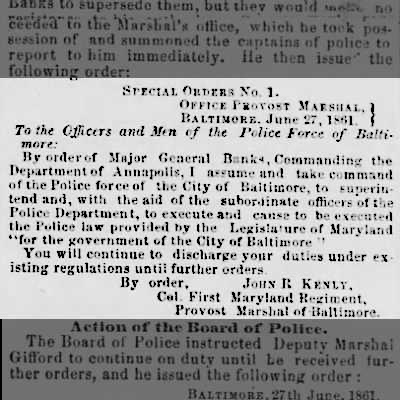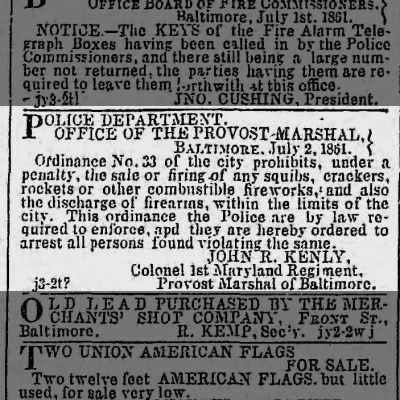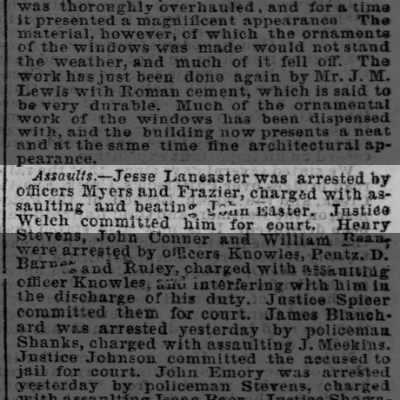Biography of Edward Myers
A Baltimore City Policeman
Edward Myers was born in Baltimore, Maryland at 4:00 AM on 11 October 1812, five months after war was declared against England. Edward was the fourth child and second son of Charles Myers (spelled Meyer) and Mary "Polly" Wagner (spelled Waggoner) of York County, Pennsylvania. Pages from the Myers Family Bible, at one time in the possession of now deceased cousin William Slaughter of Richmond, Virginia, list in the handwriting of Mary “Polly” (Wagner) Myers all of her children with specific dates and times of birth or christening.
What may have happened while Edward Myers was growing up in the Federal Hill and Baltimore Harbor area? On 27 February 1821, General Andrew Jackson arrived in Baltimore from Philadelphia and his approach was announced by discharges of artillery from a detachment of Captain Wilson's Independent Blues, stationed on Federal Hill. Edward Myers likely heard or witnessed the artillery fire as a nine-year-old. From 7 to 11 October 1824, the Revolutionary War hero, French General Lafayette, made a return visit (since 1781) to Baltimore and Edward Myers as a twelve-year-old may have witnessed the extensive celebrations in the city. Four ships fully dressed with flags and streamers sailed into the harbor to greet the General, his son Washington Lafayette, and U.S. Secretary of State, John Quincy Adams. On 13 October 1824, two days after Lafayette's departure, Edward Myers' younger brother, Ferdinand Myers, was born in Baltimore. On 6 April 1826, Edward Myers' younger sister, Julia Myers, was christened by Reverend Daniel Kurtz of Zion German Lutheran Church on Gay Street and Court House Plaza. Ferdinand Myers was christened nearly seven years after his birth on 1 June 1831, also by Reverend Daniel Kurtz. Edward Myers in 1842 lived on South Charles Street, north of Barre Street, according to the Baltimore City Directory.
On 23 May 1846, an enthusiastic crowd assembled in Monument Square of Baltimore City to support the annexation of Texas and the war that followed. Reverdy Johnson, General Sam Houston, and William Yancey, a member of Congress from Alabama, all addressed the Baltimore audience. On 1 June 1846, First Lieutenant John R. Kenly of the Eagle Artillery Company of Baltimore began recruiting a company of volunteers for the Mexican War, after first meeting with President James K. Polk in Washington, D.C., and then with Lieutenant Colonel William H. Watson, the newly appointed commander of the Baltimore and Washington, D.C. Battalion. On 2 June 1846, Kenly opened a rendezvous in the armory of the Eagle Artillery Company, and another at Trades' Union Hall, corner of Baltimore Street and Triplett's Alley. According to Kenly, volunteers came in with extraordinary rapidity. On 4 June 1846, Kenly carried to the city of Washington by railroad two officers and 58 men, the whole having been recruited by Kenly in less than 36 hours. Prior to leaving his rendezvous on Baltimore Street, Kenly was honored and gratified by being presented with a sword and sash by Captain George P. Kane, the commanding officer, on behalf of the Eagle Artillery Company, with which Kenly had been connected as a private and officer for several years. On reaching Washington, Kenly and his new recruits were met by the volunteers from Baltimore who had preceded them. Kenly and his recruits were escorted to the War Department, and from there they marched to the Marine Barracks, where the recruits were assigned quarters. Kenly received his commission as Captain from Thomas G. Pratt, Governor of Maryland, that same day.
Edward Myers enlisted for one year of military service on 4 June 1846 as a Private with Captain John R. Kenly's Company E in the Baltimore and Washington, D.C. Battalion. Edward Myers was described in his enlistment and pension records as being 5 feet 4 inches tall, of light complexion, dark eyes, dark hair, and by occupation a baker. On 5 June 1846, Captain Kenly sent two of his officers, Lieutenants Francis B. Schaeffer and Oden Bowie (later Governor of Maryland and for whom Odenton was named), back to Baltimore to bring more men, who were reportedly anxious to join Kenly's company. On 8 June 1846, Kenly's company, known as "Baltimore's Own," marched back to the War Department, where members of the company were mustered into the service of the United States by Lorenzo Thomas, Major and Assistant Adjutant-General United States Army, for 12 months of service. The company consisted of three officers and 84 non-commissioned officers and privates.
On 10 June 1846, the Baltimore and Washington, D.C. Battalion was ordered by the Secretary of War to leave the Marine Barracks, where it had been quartered, to Fort Washington, on the banks of the Potomac River, seven miles below the town of Alexandria. The cause of the unexpected order was an application from the Mayor of the City of Washington, who had been incensed at the bad behavior of some of the men, and who, as it was alleged, "had entered into a personal quarrel with them, in which it well may be supposed, he was not much the gainer." On 13 June 1846, the Battalion left Fort Washington and embarked on board the steamer Powhatan, and at 8:00 PM arrived alongside the steamer Massachusetts, lying in the river, which had been chartered by the Government to convey the Battalion and a large amount of stores to Point Isabel on the Gulf of Mexico. Kenly indicated in his diary that it had been raining hard all day and suddenly five hundred men were thrown upon a steamer of seven hundred tons' burden, whose hold and deck were covered with forage and other military stores. A scene of indescribable confusion ensued, which the darkness seemed to swell and magnify, and no repose was had on that night of chaos, except that which was obtained through pure exhaustion.
From 20 to 24 September 1846, Edward Myers fought at the Battle of Monterrey in Mexico. From December 1846 until at least April 1847, Edward Myers performed extra duty in Mexico as a baker for his battalion. According to the military service records from the National Archives for Edward Myers, he was billed by the Army $1.22 for a pair of lost Army brogans, 56 cents for a lost white bayonet scabbard belt, and 10 cents for a bayonet scabbard free plate. Edward Myers was discharged on 30 May 1847 in Tampico, Mexico and returned to Baltimore.
On 20 November 1848, Edward Myers was married in Baltimore, Maryland by Reverend Reese to Mary A. Flahart. Four children were born to this marriage: Henrietta, born 21 March 1849, Julia, Alexander, born 6 May 1853, and Edward Myers, all in Baltimore. Mary A. (Flahart) Myers died in the 1850's in Baltimore and Edward Myers was married a second time on 30 April 1866 by Reverend Burnette (also spelled Burnet) of the Baptist Church in Baltimore to Mary Elizabeth Stall, the daughter of the recently deceased Andrew J. Stall (who died 17 September 1862, Battle of Antietam) and Mary Ann Waters Roberts of Baltimore. Three children were born to this couple: Robert Charles Myers, Henry Russell Myers, and Lucy C. Myers. Edward Myers in 1851 was a baker by trade and lived on Parkin Street, south of Lombard Street. He moved to Charles Street between Hamburg and Cross Streets in 1853.
After Edward Myers became a policeman in 1853, assigned to the Southern District in Baltimore, and many of his encounters while on duty with unruly individuals in the city were recorded in history in the form of newspaper articles, as follows:
In a 4 May 1853 Baltimore Sun article: “In early May 1853, about 12:00 on Monday night, whilst Watchman Myers of the Southern District was going his round, he discovered on fire a building in Spring Court, two doors from Charles Street, and succeeded in extinguishing the flames before much damage was sustained.”
In a 25 January 1854 Baltimore Sun article: “Riotous Conduct: Jeremiah Simpson, on the charge of riotous conduct at Camden Station, was arrested by Watchman Edward Myers, and committed to jail by Justice Pennington, in default of security to answer before court.”
In a 16 June 1854 Baltimore Sun article: “Rescued from Drowning: About 1:00 yesterday morning, whilst Watchman Myers was going his round, he heard a man struggling in the water at Light Street Wharf. He hurried to the spot and succeeded in saving the life of the man, who was from the Eastern Shore, and who fell overboard whilst attempting to board a vessel.”
In a 6 July 1854 Baltimore Sun article: “Dreadful Railroad Accident, Awful Loss of Life, 28 Person Killed, 50 or 60 Persons Wounded” - Edward Myers was mentioned three times as Southern District Watchman, Mexican War veteran, or resident of 216 Barre Street. Edward Myers was seriously injured in this Baltimore and Susquehanna Railroad train accident nine miles from Baltimore City. George Butler, his travel companion and also a Mexican War veteran, pulled Edward Myers out of the wreckage and saved his life. The newspaper article stated how surprised authorities were that Edward Myers survived.
In a 27 December 1854 Baltimore Sun article: “George Sahn was arrested by Officer Myers, and was charged with assaulting and beating Catharine Wollen. George Sahn was committed for court by Justice Auld.”
In a 5 April 1855 Baltimore Sun article: “Passing Counterfeit Money: Jacob Wyre was arrested by Watchman Myers upon the charge of passing a five dollar bank bill on the Bank of Commerce, and which proved to be a counterfeit. Justice Lawder committed him to jail in default of security for a further examination.”
In a 15 January 1857 Baltimore Sun article: “Incendiarism: Watchman Myers of the Southern District, whilst going his rounds on Tuesday morning, discovered that the house on the corner of Perry and Hanover Streets had been forced open and then set on fire under the stairway, which Watchman Myers promptly extinguished.”
In an 11 March 1857 Baltimore Sun article: “S. Leonard was arrested by Officers Myers and Poulton upon the charge of assaulting and beating Aquilla Christopher. S. Leonard was held to bail to answer at court by Justice Webb.”
In a 14 April 1857 Baltimore Sun article: “William Bryan and Lawrence Buck were arrested by officers Myers and Poulton on the charge of throwing bricks in the street. Justice Webb fined them each one dollar with costs, and committed them to jail in default of security to keep quiet for six months.”
In a 30 May 1857 Baltimore Sun article: “About 1 o’clock on Friday morning, Officer Myers of the Southern District discovered a man sitting upon the curbstone in Pratt Street. Officer Myers accosted him, and by his incoherent replies, concluded the man was under the influence of liquor, as he appeared very drowsy. With assistance, the man was carried toward the Southern Station but died before his bearers could arrive there. His name is unknown and nothing was found upon his person by which his name or residence could be learned. Coroner Benson was sent for and he held an inquest over the body, and the jury rendered a verdict of death by intoxication.”
In a 14 August 1857 Baltimore Sun article: “Andrew Hackett was arrested by Officer Myers and was charged with exposing his person in the Hanover Market. Justice Webb committed him for court.”
In a 12 December 1857 Baltimore Sun article: “On Thursday night, Officers Myers and Coulton (previously named as Poulton) of the Southern District, arrested Mark Silverstine, a manufacturer of hats, on a charge of setting fire to his store, No. 171 West Pratt Street, an account of the partial burning of which appeared in our last issue. At first, the fire was supposed to have originated from the accident, but something excited suspicion against him and caused his arrest. He was examined before Justice Boyd, who in default of security, committed him to jail to await the reaction of the grand jury.”
In a 6 April 1858 Baltimore Sun article:


